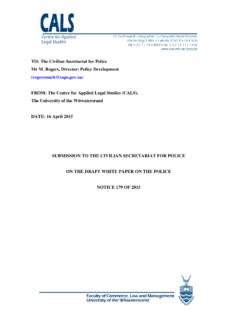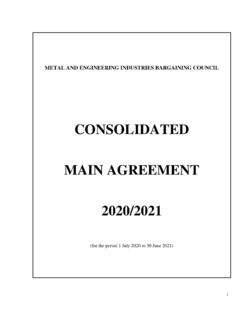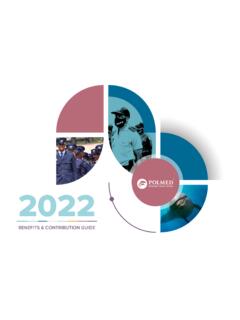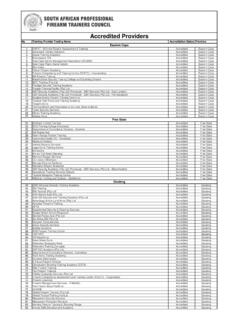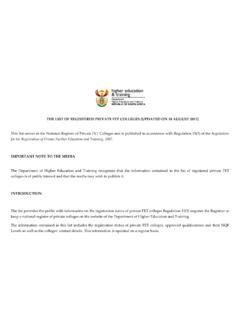Transcription of IN THE HIGH COURT OF SOUTH AFRICA EASTERN CAPE …
1 IN THE HIGH COURT OF SOUTH AFRICA EASTERN cape DIVISION, GRAHAMSTOWN CASE NUMBER: 899/2020 In the matter between: - WEZIWE TIKANA-GXOTIWE Applicant and LUNGILE MXUBE Respondent RESPONDENT S HEADS OF ARGUMENT INTRODUCTION 1. We submit that the applicant (referred to herein as the MEC interchangeably) has not made out a case for the relief sought, which relief, inter alia, is a claim that the applicant has been defamed. 2. Our heads of argument are structured as follows: - Firstly, we state that the claim brought by the applicant is vague and embarrassing and that the applicant has not made out a case for defamation; Secondly, we argue that a final order on motion is inappropriate and the - 2 - matter should be dismissed as it should have been brought on trial; Thirdly, we set out the defences of truth and public benefit as well as that of fair comment in the event that the COURT finds that the statements are defamatory in nature.
2 VAGUE AND EMBARRASSING 3. The applicant states that the Facebook posts annexed to her founding affidavit are defamatory of the applicant. 4. We submit that the failure to specify the defamatory passages may render the pleading vague and embarrassing in certain circumstances. 5. In Deedat v Muslim Digest1 the COURT stated that: - A plaintiff is entitled to rely on the whole of an article if he claims that the whole of it is defamatory of him. He may however in an appropriate case be under a duty to furnish the defendant with particulars of those portions or words upon which he specifically relies.
3 There is no hard and fast rule which dictates such a duty. In each case the matter complained of as being defamatory has to be considered and the COURT has to ask itself whether in the particular circumstances the defendant would or would not be embarrassed in the pleading. The test is not the length of the document but the nature of the matter complained of. 1 1980 (2) SA 922 (D) at 928. - 3 - 6. In Kruger v Johnnic Publishing (Pty) Ltd and Another2 Botha J held that in an action for damages for defamation it will depend on the circumstances whether it will be required of a plaintiff to indicate the defamatory passages in a document which he alleges to be defamatory as a whole.
4 The test is not the length of the document but the nature of the contents. Where the content of the document varies in degrees of offensiveness and a number of potential defences are open to the defendant, the plaintiff may be required to identify the defamatory passages. Since the abolition of a request for further particulars for pleading, there is a greater need for particularity in pleadings. 7. We submit that in the Facebook posts which are lengthy and contain many allegations. The applicant is required to identify the passages alleged to be defamatory.
5 8. We submit that the respondent is embarrassed because he does not know on which of all the potentially defamatory allegations in the Facebook posts, the MEC relies. 9. In the founding affidavit the MEC only identifies five paragraphs that are said to be defamatory. These are contained in paragraph , , and 10. These are the only occasions, in the founding affidavit, where the MEC quotes directly from the Facebook posts. She then makes the sweeping allegation in 2 2004 (4) SA 306 (T) at 309F - J.
6 - 4 - paragraph of the founding affidavit that: - The said Facebook posts portray me either expressly or implicitly as either corrupt, incompetent, lacking in integrity, involved in criminal enterprise, taking part in criminal activities and/or a liar . 11. In the replying affidavit this last quote is stressed time and time again. However, the MEC fails to state which portions of the Facebook posts imply that she is: - corrupt; incompetent; lacking in integrity; involved in criminal enterprises; taking part in criminal activity; a liar. 12. Any respondent would have different defences to each of the statements and the defamatory nature of the statements imputed thereto by the applicant or the reasonable objective reader.
7 13. In the replying affidavit the applicant states that she seeks an order declaring that the allegations about her be declared false and defamatory. She alludes to - 5 - paragraph of the founding affidavit and says that the posts make clear reference to her either by name or by title and the reasonable reader would have understood these posts to be referring to 14. The applicant should not be permitted to make a case in the replying affidavit. it is trite that our law does not permit this. We do not concede that she has made out a case in reply in any event.
8 15. The applicant states that it is clear that her case is that all portions of the posts which refer to her are defamatory and false. She fails to state in the founding affidavit or in the replying affidavit which statements are defamatory and how they give rise to the conclusion that she is corrupt, incompetent, lacking in integrity, involved in criminal enterprises, taking part in criminal activity and/or a liar. 16. We submit that the respondent cannot defend himself without any particularity as aforestated. The only time that the MEC refers to exactly which statements defame her and in what manner, is set out in the heads of argument.
9 This is inadequate. 17. The applicant states that all the statements relating to her are defamatory and all of them lead to the conclusion which she contends for above. However, there are different defences to each of the statements and the respondent is left 3 See paragraph 15 of the replying affidavit at p 136. - 6 - to guess. 18. On this premise the application ought to be dismissed. PROCEEDINGS ARE INAPPROPRIATE 19. The applicant is mindful of the risk in proceeding by way of motion. She refers to the case of Malema v Rawula4 in her heads of argument.
10 In that case Mullins AJ stated the following, which is also quoted in the applicant s heads of argument: - As far as I have been able to ascertain, bringing a defamation claim by way of application for a final interdict and damages is a new phenomenon in our law (as opposed to an interim interdict pending an action for damages). In my view, it is inappropriate and undesirable. The reason I say this is the following: The person making the defamatory statement may have a very good reason for doing so, but may not have the hard evidence to hand, which evidence may be in possession of the person who claims to have been defamed and/or third parties.

